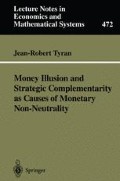Abstract
A prominent experimentalist recently criticized that experiments are sometimes abused to demonstrate “pseudo-anomalies“ (see quotation above). The author pointed out that observed behavior may very much depend on the specifics of an experimental design and its procedures. In particular, Friedman (1998: 941) states that “Every choice anomaly can be greatly diminished or entirely eliminated in appropriately structured learning environments.“ We completely agree with this assertion. In fact, this study provides an example for this statement. We have identified conditions (strategic substitutes) under which the “choice anomaly“ of money illusion does not considerably affect aggregate behavior. Controlled variations of the decision environment allowed the identification of other conditions (i.e. strategic complements) under which money illusion does have massive effects on aggregate real income. The experimental method therefore allowed the isolation of money illusion and strategic complementarity as causes of monetary non-neutrality. We suggested that the experimental results are highly relevant because strategic complementarity and the use of money are very natural features in actual macroeconomies. However, one may claim that the results are in some sense biased because all treatment conditions create an environment which is favorable to the finding of monetary neutrality, i.e. against the finding that money illusion matters. Such biases arise if the design deviates in important respects from naturally occurring economies. Since we consider this criticism to be important, this chapter takes another look at the specifics of the design and the procedures with respect to external validity of the findings (see also Part II, chapter 2).
“Recipe for Pseudo-Anomalies Ingredients
1. A common and useful rule of thumb...
2. A laboratory environment that evokes the rule of thumb when it is inappropriate
3. Subjects inexperienced in the laboratory environment.
4. Standard laboratory procedures.
5. Standard statistical techniques and standard rhetoric.
Directions
Put subjects in the laboratory environment. Run them through the standard procedures, carefully excluding any opportunities for them to learn from their experience or from imitating more successful subjects.“
Dan Friedman (1998: 941)
Access this chapter
Tax calculation will be finalised at checkout
Purchases are for personal use only
Preview
Unable to display preview. Download preview PDF.
Author information
Authors and Affiliations
Rights and permissions
Copyright information
© 1999 Springer-Verlag Berlin Heidelberg
About this chapter
Cite this chapter
Tyran, JR. (1999). Empirical relevance of results. In: Money Illusion and Strategic Complementarity as Causes of Monetary Non-Neutrality. Lecture Notes in Economics and Mathematical Systems, vol 472. Springer, Berlin, Heidelberg. https://doi.org/10.1007/978-3-642-46883-4_13
Download citation
DOI: https://doi.org/10.1007/978-3-642-46883-4_13
Publisher Name: Springer, Berlin, Heidelberg
Print ISBN: 978-3-540-65871-9
Online ISBN: 978-3-642-46883-4
eBook Packages: Springer Book Archive

